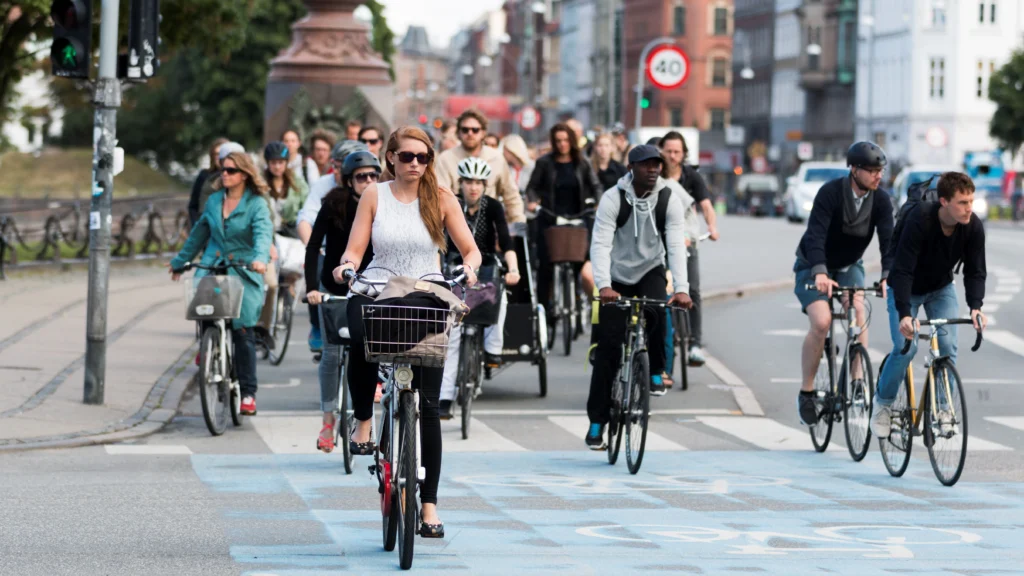
Commuting on your bike is a fantastic way to get in some daily exercise. Burning a few hundred calories is great for weight management. Getting that fresh air also really helps clearing your head after a busy day in the office. If at all possible, we highly recommend commuting to work or school on your bike. In the article you’ll learn anything you need to consider to get started.
Cycling can be a time-efficient mode of commuting, especially in congested urban areas. Bypassing traffic snarls, finding convenient parking spots, and avoiding the wait for public transportation are perks that come with two wheels and a pair of pedals.
Is commuting feasible?
The distance from your home to work or school is obviously important, to determine if commuting on your bike is feasible. We consider anything within half an hour each way perfectly fitting. Anything longer, and we get into a territory, where we need to consider if a shower is necessary upon arrival. Then you’ll need to carry extra clothes. You might also need a pair of bibs to protect your precious area.
At that point you also need to consider a race bike to improve speed and spend less time commuting. That leads to another challenge. Race bikes can’t be parked on the street, as it will be stolen no matter how good your lock is. So you need a sealed off parking area or the ability to take it inside.
How much equipment do you need to carry with you? A pc is alright, but if you also need spare clothes and a towel, most backpacks are starting to struggle. If you need to wear a suit or dress shirt, it’s not well fitted for carrying in a backpack.
You also need to consider the safety of cycling. Cities like Copenhagen and Amsterdam have great cycling paths and conditions for cyclists in general. But outside big cities, you might have to ride on roads where people are not used to cyclists, in which case safety can be a concern.
Now it might sound like there’s many challenges to commuting on your bike. But it’s just things to consider to plan your commute. We want as many people on bikes as possible! So maybe there’s a challenge for you in many days, but if you wear a suit to work and meet customers most days. Why not use casual Friday to make the day you take your bike? Even small bits can make a difference. It’s about seeing opportunities rather than limitations!
Needed gear for commuting
Besides the bike, there is a list of gear you should consider for a better experience:
- Helmet: Safety first. A well-fitted helmet is non-negotiable.
- Lights and reflectors: Ensure you’re visible, especially during low-light conditions. Front and rear lights are important, but you can also consider reflective elements on the bike and your clothing. Modern high visibility jackets are extremely effective.
- Lock: Protect your bike by investing in a sturdy bike lock.
- Fenders: Riding in rain and snow is pretty bad without fenders.
- Bike Rack or Panniers: If you need to carry items to and from work, consider a bike rack or panniers. Carrying a backpack will probably give you a wet spot on your back, as your skin won’t be able to breath and shed sweat.
- Bike Bell: Alerting other cyclists and pedestrians of your presence is easier with a bell than shouting.
- Good tires: Consider tires with a higher level of puncture resistance. They might not roll as fast, but nothing is more annoying than being late to work because of a puncture. Then you can probably also get away with not carrying tools for fixing a flat tire.
What kind of bike should you get?
Selecting the right bike for commuting depends on various factors such as your commute distance, terrain, storage options, and personal preferences. Here are a few types of bikes that are well-suited for commuting:
Hybrid Bike
- Best for: Versatility and comfort on a mix of surfaces.
- Features: Flat handlebars for an upright riding position, medium-width tires suitable for both pavement and light trails, and often equipped with mounts for racks and fenders.
Commuter-Specific Bike
- Best for: Dedicated commuting with added features.
- Features: Designed specifically for commuting, these bikes often have built-in racks, fenders, and lights. Some may also have internally geared hubs for low maintenance.
Road Bike
- Best for: Commuters with longer distances and a need for speed.
- Features: Lightweight frames, drop handlebars for an aerodynamic position, and narrow tires for reduced rolling resistance. Consider models with mounts for racks or panniers.
Single-Speed or Fixed-Gear Bike
- Best for: Commuters in flat areas or those who prefer simplicity.
- Features: Minimalist design with fewer components, making them easy to maintain. Single-speed bikes have one gear, while fixed-gear bikes (fixies) lack a freewheel, requiring constant pedaling.
Electric Bike (E-bike)
- Best for: Commuters with varying fitness levels or hilly terrain.
- Features: Electric assistance for pedaling, allowing you to cover longer distances or tackle hills with less effort. E-bikes come in various styles, including commuter-specific models.
Folding Bike
- Best for: Commuters with limited storage space or those combining biking with public transport.
- Features: Compact design that folds for easy storage. While they may have smaller wheels, modern folding bikes offer good performance and convenience.
Check out our guide for the best commuter bikes.



